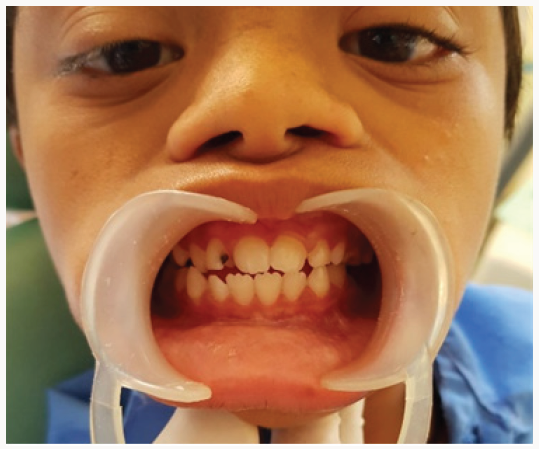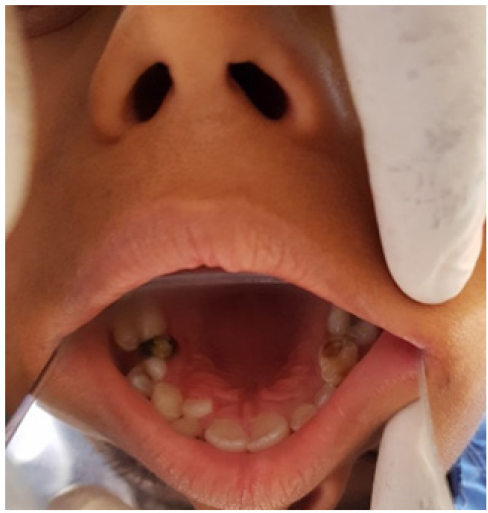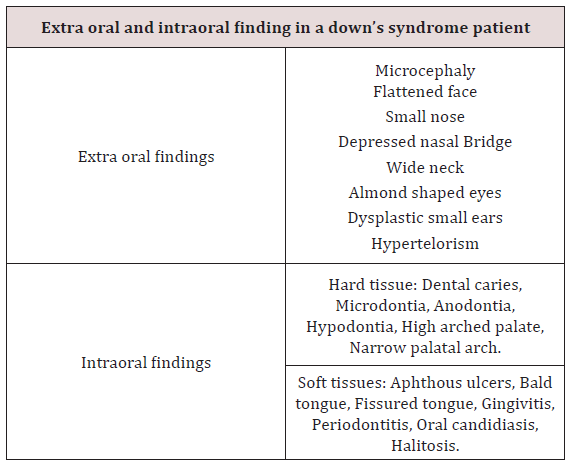
Lupine Publishers Group
Lupine Publishers
Menu
ISSN: 2637-4692
Case Report(ISSN: 2637-4692) 
Down’s Syndrome- A Disease Caused By Genetic Alteration Volume 2 - Issue 2
Vijayendranath Nayak S1*, Raghavendra Kini2, Prasanna Kumar Rao J3, Ashish S Shetty4, Nidhin Kurian4 and Soumya Shetty5
- 1Postgraduate, Department of Oral Medicine and Radiology, A J Institute of Dental Sciences, India
- 2Professor and Head, Department of Oral Medicine and Radiology, A J Institute of Dental Sciences, India
- 3Professor Department of Oral Medicine and Radiology, A J Institute of Dental Sciences, India
- 4Postgraduate, Department of Pedodontics, A J Institute of Dental Sciences, Indian
- 5Professor and Head, Department of Pedodontics, A J Institute of Dental Sciences, India
Received: April 16, 2018; Published: May 07, 2018
Corresponding author: Vijayendranath Nayak S, Postgraduate, Department of Oral Medicine and Radiology, A.J .Institute of Dental Sciences, Kuntikana, Mangaluru, Karnataka, India
DOI: 10.32474/MADOHC.2018.02.000131
Abstract
Down’s syndrome is the most common syndrome, medical professional encounters in day to day practice. It is a genetic disorder with a typical face profile and few classical intraoral features. Herein we report case and review on Down’s syndrome with facial features.
Keywords: Down’s Syndrome; Trisomy; Chromosome; Oral Manifestation
Introduction
Down syndrome is one of the commonest disorders with huge medical and social cost. DS is associated with number of phenotypes including congenital heart defects, leukemia, Alzheimer’s disease, Hirsch sprung disease etc. [1]. Down syndrome is a prevalent genetic disorder in intellectual disability in India. Its prevalence in tribal population is not known [2]. Down syndrome is one of the leading genetic causes of intellectual disability in the world. DS alone accounts 15-20% of ID population across the world [3,4].
Case Report
An 8 year old male patient came to the department of oral medicine and radiology for routine dental check-up. Extra oral examination revealed characteristic facial profile with increased inter canthal distance (Figure 1). Intraoral examination revealed Gingiva was soft with deposits on the teeth, High arched palate, with depressed nasal bridge was seen (Figure 2). Macro glossia was also seen .Correlating the intraoral and extra oral findings a Provisional diagnosis of Down’s syndrome/ Trisomy 21 was given. Patient was referred to the respective departments of pedodontics for restoration of decayed teeth.]
Discussion
Down syndrome is one of the most leading causes of intellectual disability and millions of these patients face various health issues including learning and memory, congenital heart diseases, Alzheimer’s diseases, leukemia, cancers and Hirsch rung disease. The incidence of trisomy is influenced by maternal age and differs in population [5,6]. Facial findings in the patients can be characterised into extra oral and intraoral features (Table 1) [7]. Parents of children with Down’s syndrome should be aware of these possible conditions so they can be diagnosed and treated quickly and appropriately. According to Asim A et al. A Down’s syndrome child should have regular check-up from various consultants. These include:
a) Clinical geneticist - Referral to a genetic counselling program is highly desirable.
b) Developmental paediatrician.
c) Cardiologist - Early cardiologic evaluation is crucial for diagnosing and treating congenital heart defects, which occur in as many as 60% of these patients.
d) Paediatric pneumonologist -Recurrent respiratory tract infections are common in patients with DS.
e) Ophthalmologist.
f) Neurologist/Neurosurgeon - As many as 10% of patients with DS have epilepsy; therefore, neurologic evaluation may be needed.
g) Orthopaedic specialist.
h) Child psychiatrist - A child psychiatrist should lead liaison interventions, family therapies, and psychometric evaluations.
i) Physical and occupational therapist.
j) Speech-language pathologist.
k) Audiologist.
l) Paediatric dentist.
Hackshaw AK et al in their study, proposed a new screening method in which measurements obtained during 1st and 2nd trimester are integrated to provide the risk status of having pregnancy with DS. Moderate to severe intellectual disability occur as a constant feature, with IQ’s ranging from 20 to 85 [8]. Kennard in his review stated that there are a number of ultrasound markers in Down’s syndrome which includes nuchal fold thickness, cardiac abnormalities, duodenal atresia, femur length & pyelectasis [9]. The signs and symptoms of Down’s syndrome are characterised by neotenization of brain and bodies. Management strategies such as early childhood intervention, screening from common problems, medical treatment when indicated, a conductive family environment and vocational training can improve the overall development of children with Down’s syndrome [10].
Conclusion
Genetics have always have played a major role in physical and mental being of an individual. Downs patients being mentally and medically weak, best care needs to be taken with adequate precautions.
References
- Asim A, Kumar, A, Muthuswamy S, Jain S, Agarwal S (2015) Down syndrome: An insight of the disease. J Biomed Sci 22(1): 41.
- Lakhan R, Kishore TM (2016) Down syndrome in tribal population in India: A field observation. J Neurosci Rural Pract 7(1): 40-43.
- Patterson D, Costa AC (2005) Down syndrome and genetics-A case of linked histories. Nat Rev Genet 6: 137-147.
- Understanding Intellectual Disability and Health. Down syndrome.
- Canfield MA, Honein MA, Yuskiv N, Xing J, Mai CT, et al. (2006) National estimates and race/ethnic-specific variation of selected birth defects in the United States. Birth Defects Res A Clin Mol Teratol 76(11): 747-756.
- Murthy SK, Malhotra AK, Mani S, Shara ME, Al Rowaished EE, et al. (2007) Incidence of Down syndrome in Dubai. Med Princ Pract 16: 25-28.
- Nayak V, Kini R, Rao PK (2016) Oral manifestation of trisomy 21- a report and review. Jpmr 2(6): 142-143.
- Zigman WB (2013) A typical aging in Down’s syndrome. Dev Disbil Res Rev 18(1): 51-67.
- Kennard A, Wald NJ, Mc Guire A (1997) Antenatal screening for Down’s syndrome. Journal of Medical Screening 4(4): 181-246.
- Harshithaa N, Maragathavalli G (2014) Case Report Down’s syndrome 13(1): 03-04.

Top Editors
-

Mark E Smith
Bio chemistry
University of Texas Medical Branch, USA -

Lawrence A Presley
Department of Criminal Justice
Liberty University, USA -

Thomas W Miller
Department of Psychiatry
University of Kentucky, USA -

Gjumrakch Aliev
Department of Medicine
Gally International Biomedical Research & Consulting LLC, USA -

Christopher Bryant
Department of Urbanisation and Agricultural
Montreal university, USA -

Robert William Frare
Oral & Maxillofacial Pathology
New York University, USA -

Rudolph Modesto Navari
Gastroenterology and Hepatology
University of Alabama, UK -

Andrew Hague
Department of Medicine
Universities of Bradford, UK -

George Gregory Buttigieg
Maltese College of Obstetrics and Gynaecology, Europe -

Chen-Hsiung Yeh
Oncology
Circulogene Theranostics, England -
.png)
Emilio Bucio-Carrillo
Radiation Chemistry
National University of Mexico, USA -
.jpg)
Casey J Grenier
Analytical Chemistry
Wentworth Institute of Technology, USA -
Hany Atalah
Minimally Invasive Surgery
Mercer University school of Medicine, USA -

Abu-Hussein Muhamad
Pediatric Dentistry
University of Athens , Greece

The annual scholar awards from Lupine Publishers honor a selected number Read More...
















